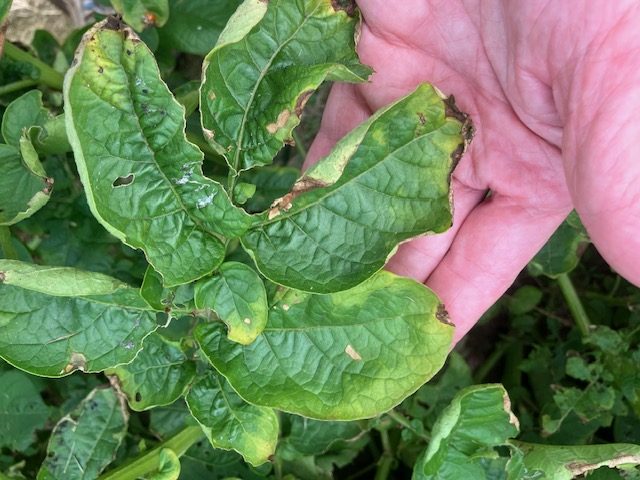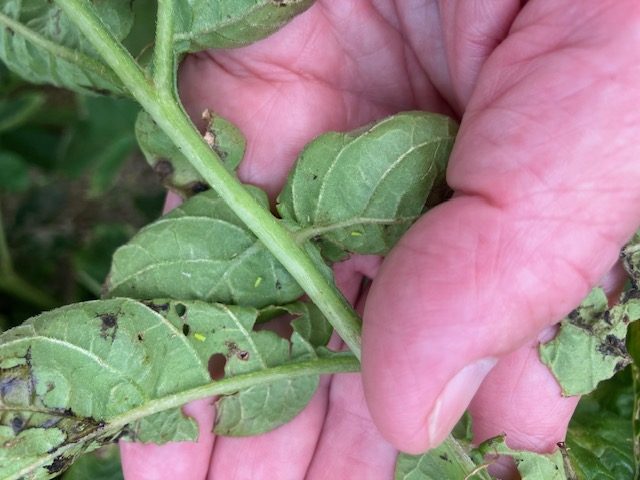Sweet Corn IPM Newsletter No. 5 — July 12, 2024
EARLY CORN HARVEST TO BEGIN IN SOUTHERN MAINE
Corn Earworm Threatens Silking Corn at Most Locations
SITUATION
The high heat continues to push corn development. Harvest of the earliest plantings may begin by the end of the week. Rainfall has been adequate in most areas, but some fields with lighter soils are now irrigating. Corn earworm and fall armyworm have been caught at most locations. Warm nights will increase moth activity and we expect numbers to keep climbing. Fresh silking corn requires protection in most fields to protect against infestation.
European corn borer: Moth counts were lower in most locations this week. We may be seeing the finish of the first generation of the NY race of this pest for the season. The Iowa strain is often later in its peak of activity, but usually is present in lower numbers in Maine. A second generation of the NY strain sometimes occurs in late summer to early fall. Sites in Dayton, Lewiston and Wells were over the spray threshold for corn borer in silking corn. Larval feeding damage in late whorl and pre-tassel was over threshold at sites in Biddeford, Bowdoinham, Farmington, Oxford, and Wells. Usually, the threshold for feeding damage at this stage is 15%, but under conditions of hot weather (over 80F) and/or damage from fall armyworm is also seen in the same field, the threshold is lowered to 12% for recommending a spray.
Corn earworm: Moths captures continue to be variable from site to site this week, as more fields come into silk. A 6-day spray interval for silking corn was recommended in Biddeford, Bowdoinham, Farmington, Oxford, and one Wells site; A 5-day spray interval was recommended in Cape Elizabeth, and Gray.
Fall armyworm: Captures of moths were more widespread this week, although we have not yet been catching high numbers. Only one location in Wells was over the three moth threshold for silking corn in pheromone traps, but the field was already under a spray interval for earworm. We continue to find small amounts of larval feeding damage on pre-tassel corn. This should be combined with any European corn borer injury found. A threshold of 12-15% of plants with fresh injury is used to determine if a spray should be applied.
Western Bean Cutworm: Moth numbers were slightly higher this week in pheromone traps. We treat this insect similarly to fall armyworm. Sprays for corn earworm or fall armyworm should protect silking corn from western bean cutworm. The optimal time for controlling the larvae is late pre-tassel to tassel.
Squash vine borer: Moth numbers in pheromone traps are over the control threshold at most locations. Sprays to protect squash plants from egg laying moths were recommended in Lewiston, Gray, Oxford, Biddeford and Monmouth. See the New England Vegetable Management Guide for control options.
Potato Leafhopper Alert! Potato leafhopper is now active in vegetable and berry fields. These small, bullet-shaped insects feed on plant sap from the undersides of leaves, causing the leaves to become curled, stunted and yellow-streaked. Beans are often the first crop to show symptoms, but other crops are also susceptible, including potatoes, peppers, eggplant, strawberries and raspberries. To scout for leafhoppers, brush the leaves of the plants with your hand. The small, whitish adults can be seen flying off the plant. Look for small, light green leafhopper nymphs on the underside of injured leaves. They are about 1/16 inch long. When touched, they will crawl sideways in a crab-like manner. See the New England Vegetable Management Guide for control options.
- Leafhopper damage showing curled, yellow streaked leaves; photo credit David Handley, UMaine Cooperative Extension.
- Leafhopper nymphs; photo credit David Handley, UMaine Cooperative Extension.
Save the date!
University of Maine Highmoor Farm Field Day: Wednesday, July 24. Orchard tours and tree fruit program 1-5 pm; Vegetable and berry tour 5-7 pm. Follow the event’s website for registration information.
Sincerely,
David T. Handley
Vegetable & Small Fruit Specialist
Highmoor Farm
P.O. Box 179
52 U.S. Route 202
Monmouth, ME 04259
207.933.2100
UMaine Extension Diagnostic Research Lab
Pest Management Unit
17 Godfrey Drive
Orono, ME 04473
1.800.287.0279
| Location | CEW Moths | ECB Moths | FAW Moths | %Feeding Damage | Recommendations / Comments |
|---|---|---|---|---|---|
| Biddeford | 3 | 2 | 1 | 19% | 6-day spray interval for silking corn |
| Bowdoinham | 2 | 2 | 1 | 16% | 6-day spray interval for silking corn |
| Cape Elizabeth | 6 | 2 | 1 | 14% | 5-day spray interval for silking corn |
| Dayton | 1 | 7 | 2 | 20% | 1 spray for ECB feeding on silking corn |
| Farmington | 2 | 12 | 0 | 13% | 6-day spray interval for silking corn |
| Garland | 0 | 0 | 0 | 0% | No spray recommended |
| Gray | 6 | 0 | 0 | 2% | 5-day spray interval for silking corn |
| Lewiston | 3 | 4 | 0 | 12% | 6-day spray interval for silking corn |
| Lewiston II | 0 | 5 | 1 | 6% | 1 spray for ECB feeding on silking corn |
| Oxford | 2 | 1 | 2 | 19% | 6-day spray interval for silking corn |
| Palmyra | 0 | 0 | 1 | 3% | No spray recommended |
| Wayne | 0 | 0 | 0 | 0% | No spray recommended |
| Wells I | 0 | 7 | 0 | 37% | 1 spray for ECB feeding on silking corn |
| Wells II | 2 | 1 | 3 | 15% | 6-day spray interval for silking corn |
CEW: Corn earworm (Only fresh silking corn should be sprayed for this insect.)
ECB: European corn borer
FAW: Fall armyworm
| Moths caught per week | Moths caught per night | Spray Interval |
|---|---|---|
| 0.0 to 1.4 | 0.0 to 0.2 | No spray |
| 1.5 to 3.5 | 0.3 to 0.5 | Spray every 6 days |
| 3.6 to 7.0 | 0.6 to 1.0 | Spray every 5 days |
| 7.1 to 91 | 1.1 to 13.0 | Spray every 4 days |
| More than 91 | More than 13 | Spray every 3 days |
Thresholds apply only to corn with exposed fresh silk. Lengthen spray intervals by one day if maximum daily temperature is less than 80°F.
European Corn Borer Thresholds
Whorl stage: 30% or more of plants scouted show injury.
Pre-tassel-silk: 15% or more of plants scouted show injury.
Silk: 5 or more moths caught in pheromone traps in one week.
IPM Web Pages:
Explore Integrated Pest Management in Maine — UMaine
Integrated Pest Management Data Visualization Tool — Penn State
Integrated Pest Management — UMass Amherst
Where brand names or company names are used, it is for the reader’s information. No endorsement is implied nor is any discrimination intended against other products with similar ingredients. Always consult product labels for rates, application instructions and safety precautions. Users of these products assume all associated risks.
In complying with the letter and spirit of applicable laws and pursuing its own goals of diversity, the University of Maine System does not discriminate on the grounds of race, color, religion, sex, sexual orientation, transgender status, gender, gender identity or expression, ethnicity, national origin, citizenship status, familial status, ancestry, age, disability physical or mental, genetic information, or veterans or military status in employment, education, and all other programs and activities. The University provides reasonable accommodations to qualified individuals with disabilities upon request. The following person has been designated to handle inquiries regarding non-discrimination policies: Director of Equal Opportunity, 5713 Chadbourne Hall, Room 412, University of Maine, Orono, ME 04469-5713, 207.581.1226, TTY 711 (Maine Relay System).


